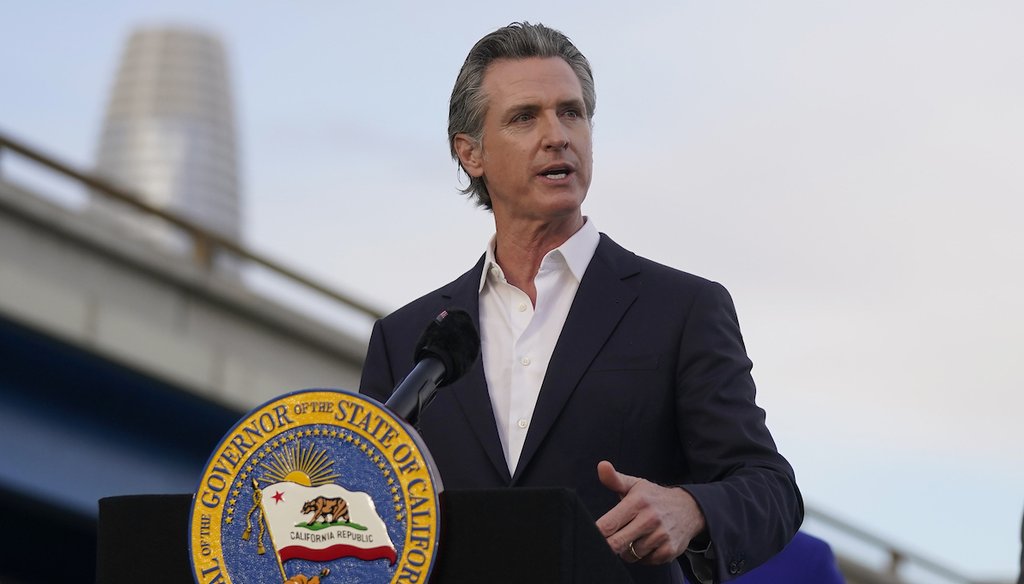Get PolitiFact in your inbox.

California Gov. Gavin Newsom speaks at an event in San Francisco, Nov. 9, 2023. (AP)
If Your Time is short
-
A January 2024 paper estimated that there have been 64,565 rape-induced pregnancies in 14 states that have enacted total abortion bans since June 2022.
-
Researchers used federal and state data on U.S. rape incidence, and refined it by women of reproductive age. But the paper had limitations and was based on a number of assumptions, making it difficult to determine precisely how many rapes and births have occurred.
-
Still, given the difficulty some rape survivors might have seeking out-of-state abortions, experts said it is likely many rape-induced pregnancies were carried to childbirth.
-
Our mission: Help you be an informed participant in democracy. Learn more.
Abortion rights advocate California Gov. Gavin Newsom has launched ads criticizing efforts in Republican-led states to stop women from traveling out of state for abortions.
On CNN’s "The Lead" with Jake Tapper, the Democrat bashed the recent Alabama Supreme Court ruling that said frozen embryos should be considered children. Newsom then shared an eye-popping figure about rape-related births in states with abortion bans.
"You’ve seen the statistic: 65,000 births due to rapes since Dobbs in 14 states," Newsom told Tapper on Feb. 23, referring to the 2022 Supreme Court ruling in Dobbs v. Jackson Women’s Health Organization. "Apparently, what the Republican party says, is that the rapist has more right to bring those babies to birth than families that are trying desperately to have the privilege that you and I have had as fathers and parents. It’s a disgrace."
In Dobbs, the Supreme Court overturned the 1973 Roe v. Wade decision that federally protected abortion access. Dobbs returned power to individual states to set their own laws.
Newsom’s figure came from a January research letter from reproductive health researchers, including one expert from Planned Parenthood, which advocates for abortion access. The letter estimated about 64,565 pregnancies have been caused by rape in 14 states with total abortion bans since the Dobbs decision.
Nine of the states don’t have exceptions for rape or incest; most that do allow abortion only through the first weeks of pregnancy, and require the sexual assault to be reported to law enforcement first.
The researchers said these were pregnancies — not necessarily births, as Newsom said. And the paper referred to a report that found that even states with rape exceptions recorded fewer than 10 abortions per month, increasing the likelihood that the mothers carried the pregnancies into term.
The paper’s authors acknowledged that they don’t know from the data how many of these pregnancies ended in miscarriage or births. It’s also unclear how many rape-induced pregnancies were terminated in out-of-state abortions.
Newsom’s office told PolitiFact that he was surmising that the number represented births because these states have total abortion bans.
"Those 65,000 people who become pregnant due to rape are no longer afforded the same legal reproductive rights they were prior to Trump & Republican-appointed Justices overturning Roe — forcing them to give birth to their rapists’ baby," Newsom spokesperson Brandon Richards wrote in an email.
Rachel Perry, a board-certified OB-GYN at UCI Health in California, said that although the study’s pregnancy number is an estimate, its methodology is sound and draws from the best available data.
"At this time, there is no way to determine how many people in these states are able to access abortion in general, or specifically for rape-related pregnancy," she said.
Here’s a closer look at the paper’s findings.
The research letter was published by JAMA Network and authored by researchers from Planned Parenthood of Montana; Resound Research for Reproductive Health in Austin, Texas; Hunter College, City University of New York; Cambridge Health Alliance in Massachusetts; and the University of California, San Francisco.
The authors used years-old data from federal sources to arrive at the post-Dobbs estimate of 64,565 pregnancies from July 1, 2022, to Jan. 1, 2024. Those data sources included the U.S. Centers for Disease Control and Prevention’s National Intimate Partner and Sexual Violence Survey from 2016 to 2017 and 2019 FBI Uniform Crime Report data showing reported rapes by state.
The CDC’s annual sexual violence telephone survey involved 15,152 women and 12,419 men ages 18 and older and included detailed responses to numerous questions about the nature of their experiences with sexual violence. Using that data, the letter’s authors estimated the national incidence of "vaginal rape" in combination with FBI data focused on states with total abortion bans: Alabama, Arkansas, Idaho, Indiana, Kentucky, Louisiana, Mississippi, Missouri, North Dakota, Oklahoma, South Dakota, Tennessee, Texas and West Virginia.
With these calculations, the authors determined that there were about 519,981 vaginal rapes among women ages 15 to 45 in those states and about 12.4% of these survivors had resulting pregnancies. That brought the number of estimated pregnancies in those states to 64,565.
Of those pregnancies, the authors estimated that 9% occurred in states with abortion bans that have exceptions for rape, and 91% in states with no rape exceptions and that Texas had the highest rate of rape-related pregnancies, 26,313.
Kari White, a report co-author and executive and scientific director of Resound Research for Reproductive Health in Austin, Texas, said researchers used the CDC survey data because rapes are "vastly underreported."
"It’s considered one of the most accurate sources of information on people’s experience of sexual violence, and is considered to be very good, though unlikely perfect, at capturing reported and unreported rapes," White said. "A limitation is we are assuming any underreporting is consistent across places, but to drill down to the state level, we had to rely on a couple different data sources to make our estimate."
Using research from the Society of Family Planning, a nonprofit organization specializing in abortion and contraception science, the study’s authors found that 10 or fewer abortions occurred each month in states with exceptions for rape. This, the report said, suggests the exceptions "fail to provide reasonable access to abortion for survivors."
Reproductive health experts we spoke with agreed that, because the paper relies on indirect estimations and several data sources, the assumptions can’t be fully validated.
The possibility of miscarriage, which can occur in 10% to 15% of pregnancies, complicates determining how many rapes led to births, as does the uncertainty of how many rapes led to pregnancies. And some women may have traveled out of state for abortions.
Alison Gemmill, an assistant professor at Johns Hopkins Bloomberg School of Public Health, said there isn’t reliable data about who can access abortion in states that ban it.
"This study provides an estimate of rape-related pregnancies in banned states since Dobbs, but it’s not based on data that directly capture this information, let alone data collected post-Dobbs," said Gemmill. "Instead, it uses multiple data sources and several assumptions to come up with an empirically-derived estimate. This is perhaps the best researchers can do because data that would enable a direct calculation of rape-related pregnancies do not exist."
Although some women may have traveled across state lines for abortions, the distances may hinder some of the most vulnerable rape survivors. Time magazine chronicled the story of a 13-year-old girl who gave birth after her mother said she was raped. She was denied an abortion in Mississippi, her home state, and the closest abortion provider was located more than a nine-hour drive away, in Chicago — a trip her family couldn’t afford.
"For many of the states we looked at, the people living in those states are facing travel distances of 300 to 800 miles to get to another place where abortion is legal and that is going to be a really difficult travel obstacle to overcome," White said. "Particularly given what we know about people who are survivors of rape — many of them are in unsafe relationships or in dangerous family situations, making it even more difficult to travel."
It’s also worth noting that older research examining rates of rape-related pregnancies have calculated it differently. A 1996 study published by the American Journal of Obstetrics and Gynecology put the national rate at 5% per rape among survivors ages 12 to 45. In 2018, a separate study found about 16% of all rape survivors experience pregnancy.
Perry said that although the data is hard to accurately quantify, she doesn’t doubt the picture that the research letter paints.
"I think it’s reasonable to assume that most rape-related pregnancies in states with bans result in birth, given how difficult it is to access abortion for many individuals (the cost of travel is prohibitive, or the fear of legal risk is too high)," she said.
Gemill echoed that point: The data that does exist tells us rape related pregnancies occur in states that ban abortion, she said.
"We know from CDC data that over 2.5 million women in the U.S. reported experiencing sexual violence in the previous 12 months," Gemill said, "so it seems feasible that some women living in banned states would experience rape-related pregnancy."
Our Sources
TV Eyes, Gov. Gavin Newsom on CNN, Feb. 23, 2024
JAMA Network, Rape-Related Pregnancies in the 14 US States With Total Abortion Bans, Jan. 24, 2024
JAMA Network, Editors Note: Editors Note: Access to Safe Abortion for Survivors of Rape, Jan. 24, 2024
The U.S. Centers for Disease Control and Prevention, The National Intimate Partner and Sexual Violence Survey 2016/2017, October 2022
Society of Family Planning, #WeCount Public Report April 2022 to September 2023, Accessed Feb. 29, 2024
American Journal of Obstetrics and Gynecology Rape-related pregnancy: Estimates and descriptive characteristics from a national sample of women, August 1996
American Journal of Preventitive Medicine, Rape-Related Pregnancy and Association With Reproductive Coercion in the U.S., December 2018
PBS, In states with abortion bans, rape exceptions ‘fail to provide reasonable access’ to survivors, researchers say, Jan. 24, 2024
NPR, Raped, pregnant and in an abortion ban state? Researchers gauge how often it happens, Jan. 24, 2024
Time, She Wasn’t Able to Get an Abortion. Now She’s a Mom. Soon She’ll Start 7th Grade, Aug. 14, 2023
Scientific American, 64,000 Pregnancies Caused by Rape Have Occurred in States with a Total Abortion Ban, New Study Estimates, Jan. 25, 2024
CNN, Births have increased in states with abortion bans, research finds, Nov. 21, 2023
The New York Times, Most Abortion Bans Include Exceptions. In Practice, Few Are Granted., Jan. 21, 2023
Indiana Capital Chronicle, 17 abortions meet exceptions under ban, new report shows, Jan. 1, 2024
Phone interview, Kari White, executive and scientific director of Resound Research for Reproductive Health at the University of Texas at Austin, Feb. 28-March 6, 2024
Email interview, Brandon Richards, spokesperson for Gov. Gavin Newsom, Feb. 28-29, 2024
Email interview, Alison Gemmill, assistant professor at Johns Hopkins Bloomberg School of Public Health, Feb. 28-March 6, 2024
Email interview, Rachel Perry, board-certified obstetrician and gynecologist at UCI Health, Feb. 29, 2024
Phone and Email interview, Dr. Samuel Dickman, chief medical officer at Planned Parenthood of Montana, March 6, 2024














































